
Doncaster Rovers Football Club is a professional association football club based in Doncaster, South Yorkshire, England. The team compete in League Two, the fourth level of the English football league system. The club play their home games at the Eco-Power Stadium, having moved from Belle Vue in 2007. Their home strip consists of red and white hoops, which has been the main design of the club's home shirt since 2001 through different variations.
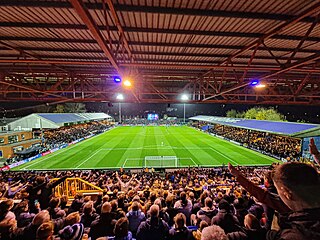
Edgeley Park is a football stadium in Edgeley, Stockport, England. Built for Stockport RFC, a rugby league club, in 1891, by 1903 the rugby club was defunct and Stockport County Football Club moved in. Sale Sharks Rugby Union Club also played at the ground between 2003 and 2012.

Maine Road was a football stadium in Moss Side, Manchester, England, that was home to Manchester City from 1923 to 2003. It hosted FA Cup semi-finals, the Charity Shield, a League Cup final and England matches. Maine Road's highest attendance of 84,569 was set in 1934 at an FA Cup sixth round match between Manchester City and Stoke City, a record for an English club ground.

Deepdale is a football stadium in the Deepdale area of Preston, England, the home of Preston North End. Deepdale is widely recognised as being the oldest continuously used football stadium in the world, though this is contested.
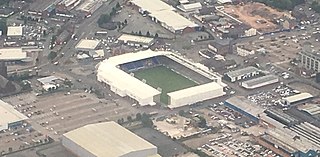
The Halliwell Jones Stadium is a rugby league stadium in Warrington, England, which is the home ground of the Warrington Wolves. It has also staged Challenge Cup semi-finals, the European Nations Final, the National League Grand Finals' Day, two games of the 2013 Rugby League World Cup and four games of the 2021 Rugby League World Cup.

Ewood Park is a football stadium in Blackburn, Lancashire, England, and the home of Blackburn Rovers F.C., founding members of the Football League and Premier League, who have played there since 1890. It is an all seater multi-sports facility with a capacity of 31,367, and four sections: the Bryan Douglas Darwen End, The Ronnie Clayton Blackburn End, the Riverside Stand, and Jack Walker Stand, named after Blackburn industrialist and club supporter, Jack Walker. The football pitch within the stadium measures 115 by 76 yards
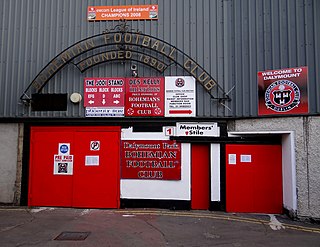
Dalymount Park is a football stadium in Phibsborough on the Northside of Dublin, Ireland.
Belle Vue is an inner suburb of Doncaster, South Yorkshire, England.

The City Ground is a football stadium in West Bridgford, Nottinghamshire, England, on the banks of the River Trent. It has been home to Nottingham Forest since 1898 and has a capacity of 30,455.

Glenmalure Park, often simply known as Milltown, was a football stadium on the Southside of Dublin city in Ireland. Located in the suburb of Milltown, it was home to Shamrock Rovers from 1926 to 1987, when it was sold to property developers by the club's directors. It is now a housing estate called Glenmalure Square.
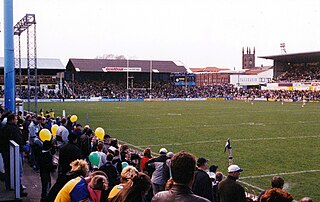
Wilderspool Stadium was a rugby league stadium in Warrington, England. The ground was Warrington RLFC's old ground before moving to the Halliwell Jones Stadium.

Consett Association Football Club is a football club based in Consett in County Durham, England. They are currently members of the Northern Premier League Division One East and play at Belle View Stadium.

Prenton Park is a football stadium in the area of Prenton, Birkenhead, Merseyside, England. It is the home ground of Tranmere Rovers Football Club since opening in 1912, and formerly the home ground of Liverpool Reserves and Liverpool Women. The ground has had several rebuilds, with the most recent occurring in 1995 in response to the requirement of the Taylor Report to become all-seater. The stadium now holds 16,587 in four stands: the Kop, the Johnny King Stand, the Main Stand and the Cowshed for away supporters.

The Eco-Power Stadium is a multi-purpose stadium in Doncaster, England, with a capacity of 15,231. It cost approximately £20 million to construct, as part of the wider Lakeside Sports Complex that it resides within which in total cost approximately £32 million, and is used by Doncaster Rovers, Doncaster Rugby League Club and Doncaster Rovers Belles Ladies Football Club.

Belle Vue is a multi-purpose stadium in Rhyl, Wales. It is used mostly for football matches, and is the home ground of C.P.D. Y Rhyl 1879. The stadium holds 3,000 people, with a seating capacity of 1,720.

Belle Vue, also known as the DIY Kitchens Stadium for sponsorship reasons, in Wakefield, England, is the home of Rugby League club Wakefield Trinity RLFC and Association Football club Wakefield A.F.C. It is on the A638 Doncaster Road, a mile south of Wakefield city centre.
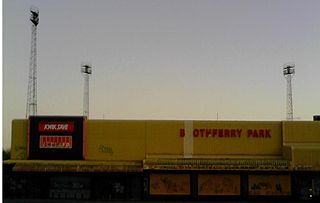
Boothferry Park was a football stadium in Hull, England, which was home to Hull City A.F.C. from 1946 until 2002, when they moved to the KC Stadium.

Doncaster Rovers Belles Ladies Football Club, previously Doncaster Belles, is an English women's football club that currently plays in the FA Women's National League Division One North, the fourth tier of women's football in England. The club's administration is based at their home ground of Eco-Power Stadium in Doncaster, South Yorkshire.

Crown Flatt, currently known as the FLAIR Stadium for sponsorship purposes, is a rugby league stadium in Dewsbury, West Yorkshire, England. It is the home of the Dewsbury Rams, who play in the Championship. The ground occupies the site of the former Shaw Cross Colliery, which closed in August 1968.
Redheugh Park was a football stadium in Gateshead, England. The stadium was built in 1930 when South Shields F.C. moved to Gateshead from Horsley Hill and became Gateshead AFC. It was their home for more than 40 years.



















